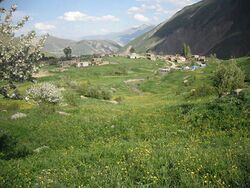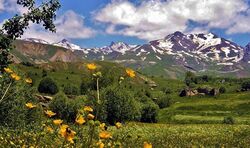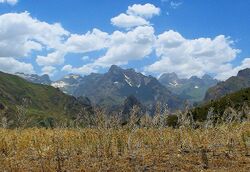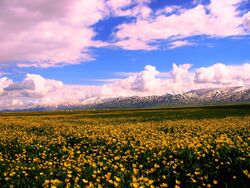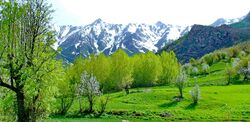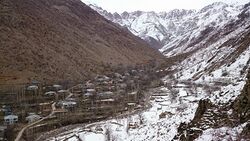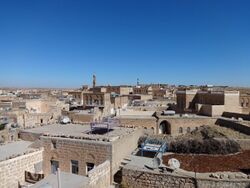Place:List of Assyrian tribes
This page features a list of Assyrian clans or tribes historically centered in the Hakkari, Sirnak and Mardin provinces in Turkey and West Azerbaijan Province in Iran,[1] prior to 1915, or before Seyfo, when they were historically Assyrian settlements, before early 20th century resettlement in Northern Iraq (which simultaneously had Catholic-Assyrian tribes since the 1st millennium) and northwestern Syria (namely in Al-Hasakah) after they were displaced, slaughtered and driven out by Ottoman Turks in 1915 and in the early 1930s, respectively, during the Simele massacre where they endured a similar anguish and predicament.[2]
From around 2500 BC, Assyrians primarily lived in the ancient Assyrian cities of Nineveh, Assur, Nohadra, Arrapha and Arbela, which now lie in modern-day northern Iraq, and as well as the mountainous Assyrian region of Hakkari in what is now Turkey, from around 2300 BC.[3] Though after the spread of Islam, many eventually left the ancient Assyrian cities in the Nineveh Plains, where they settled and found refuge in the highland region in southeastern Anatolia, with the existing Assyrian population, and northwestern Iran.[4] The villages in southeastern Turkey are primarily centred in the modern-day towns of Yuksekova, Çukurca and Semdinli in Hakkâri, Uludere in Sirnak Province and Tur Abdin in Mardin Province.[5]
Most of the historical Assyrian tribes are located in the region stretching from Tur Abdin to Hakkari, in Upper Mesopotamia, which formed the Nairi lands, serving as the northern Assyrian frontier and border with their Urartian rivals. The Assyrians of this region were Nestorian Christians adhering to the Assyrian Church of the East and lived here until 1924, when the very last Assyrians who survived the Assyrian Genocide and massacres that occurred during 1918 were expelled. Most subsequently moved to the Nahla valley in northern Iraq or elsewhere.[6]
The people of these tribes are an ancient people of Mesopotamia who speak Assyrian Neo-Aramaic, a modern Syriac language that's derived from old Aramaic and has influences of Akkadian.[7] In the early-mid 20th century, most settled in Iraq, Jordan, Syria and Iran, where many eventually immigrated to the western world in recent years.[8][9]
Iran
In 1900, Assyrians numbered over 76,000 in northwestern Iran, constituting over a quarter of the West Azerbaijan Province's population and were the largest non-Muslim majority in Urmia. Of the 300 villages around Urmia, 60 were exclusively Assyrians and 60 were mixed villages with Assyrian, Armenian, and Azeri communities. Nevertheless, there were over 115 documented Assyrian villages to the west of Lake Urmia prior to 1918. The home of the Assyrians in Iran has traditionally been along the western shore of Lake Urmia from the Salmas area to the Urmia plain.
Although similar to Iraq Koine, where Koine ultimately derives from it, the Urmian dialect of this region has Farsi influence (such as the use of [v] instead of [w]), where, for instance, warda ("flower") will pronounced as "varda". Furthermore, unlike many Iraqi Koine speakers, Urmians are also influenced by Azerbaijani language spoken in the region, /tʃ/ instead of /k/ and /dʒ/ instead of /g/ – So for example, words like kma ("how much") in Standard Assyrian (Iraqi Koine) will be chma, and gana will be jana ("self"), respectively. Incidentally, /dʒ/ may also be used in some Tyari dialects as well. Furthermore, in many Urmian speakers, namely those who come from Iran, the long /a/ sound as heard in "raba" ("plenty") will be turned into an /ɒ/ sound, so the word may sound like "robo".[10]
The Urmia dialect was the prestige dialect of Assyrian Neo-Aramaic in the 19th and early 20th century, when it was chosen by Justin Perkins, an American Presbyterian missionary, for the creation of a standard literary dialect of Assyrian, before ultimately a second standard dialect derived from General Urmian known as "Iraqi Koine" was developed in the 20th century.[11]
- Naqadeh County
- Suldoz – Many Assyrians from this town resettled in Habbaniyah, Iraq in the early 20th century.
- Urmia County
- Margawar District
- Razhani
- Nergi
- Gerdiki
- Diza
- Gullistan
- Salamas
- Chara
- Zewajik
- Ulah
- Guliser
- Khanaga
- Patamur
- Sawra
- Delemon
- Mahlam
- Sarna
- Tergawar District
- Anbi
- Balulan
- Darband
- Dastalan
- Haki
- Mar Behisho
- Mavana
- Qurana
- Salona
- Shibani
- Tuleki
- Tulu
- Sumay-ye Beradust District
- Urmia
- Mawana
- Mushabad
- Charbash
- Borashan
- Anhar
- Gulpashan
- Gug Tappeh
- Darbarut
- Mar Sargis
- Seiri
- Shirabad
- Kirakiz
- Chamaki
- Kuchiye
- Nazi
- Kosi
- Gangachin
- Sopurghan
Iraq
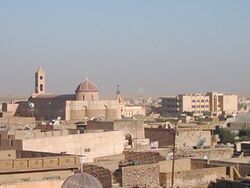
Most traditional Assyrian settlements in Iraq, which were once ancient cities home to Assyrians, are now towns or small cities in Iraqi Kurdistan and Iraq that are largely populated by Kurds and Arabs, with Assyrians being a significant minority. Such townships include Alqosh, Tel Keppe, Bartella and Tel Esqof (which are historical Chaldo-Assyrian tribes) in Nineveh Governorate and Nineveh plains, and the Kurdish-populated cities of Dohuk and Zakho (another Chaldo-Assyrian tribe) in Dohuk Governorate. Batnaya, in the Tel Keppe District in Nineveh Governorate, is a Chaldo-Assyrian tribe.[14]
The Assyrians inhabiting Nineveh Province are mostly adherents of the Chaldean Catholic Church, whilst those in Dohuk adhere to the Assyrian Church of the East and Ancient Church of the East. Many Assyrians native to southeastern Turkey have settled in Northern Iraq from the 1920s and 1930s after torment, genocidal violence and discrimination, whilst some immigrated to Syria and the Caucasus. The nearby ancient Assyrian cities of Assur and Nineveh scarcely have Assyrians, if any, due to Iraq War and spread of ISIL.[15]
Barwar (Lower)
Located in what is now Northern Iraq, Lower Barwari is a region in Iraq that is native to Assyrian people and one of the few historical Assyrian regions to still have an Assyrian presence in the modern era. The Assyrians indigenous to this territory speak a dialect that is virtually homogeneous to those of the Lower Tyari region in southeastern Turkey, and unlike those in the Upper Barwari region. Ancient villages of this region includes Dooreh, Dehi, Bebadi, Jelek and Betanure. The mountainous region was part of the diocese of Beth Nuhadra (current day Dohuk) since antiquities and have seen a mass migration of Nestorians after the fall of Baghdad in 1258 and Timurlane's invasion from central Iraq.[16]
Its Christian inhabitants were little affected by the Ottoman conquests, however starting from the 19th century Kurdish Emirs sought to expand their territories at their expense. In the 1830s Muhammad Rawanduzi, the Emir of Soran, tried to forcibly add the region to his dominion pillaging many Assyrian villages. Bedr Khan Beg of Bohtan renewed attacks on the region in the 1840s, killing tens of thousands of Assyrians before being ultimately defeated by the Ottomans.[17]
Many Assyrians who survived later suffered in the Assyrian Genocide by the Ottoman Army during the First World War; others took refuge in Urmia led by their patriarch, Mar Shimun XIX Benyamin. Later attempts for their resettlement in Barwar were largely successful however, and Assyrians still live in the region.[18]
Akin to the speakers of Lower Tyari, "beta" in Standard Assyrian will be "betha" in the lower Barwar dialect, making the dialect overall similar to, and overlapping with, the Tyari dialects in Hakkari.[19]
Turkey
Albaq
Qalanis is situated in the district of Albaq in Yüksekova, Hakkari province, Turkey. Prior to 1915 it was a purely Assyrian settlement, home to more than 25 households with three churches.
Be-Aziza
Located in Dilek, Oğul, Hakkari, the village of Be-Aziza was home to nearly 50 households prior to 1915, with two ancient churches. The largest and most important of these was dedicated to St. George. The village takes its name from the historic figure of King Aziz of Tal, who lived in the 4th-5th centuries AD and was the father of St. Talya (Mar Tlaye). In 1935, many Assyrians from Be-Aziza, who are called "Aziznaye", were resettled, with other Assyrians from Tal, in the village of Tell-Tal, on the banks of the Khabur River in Syria.
Barwar (Upper)
Situated to the northwest of Upper Tyari in Hakkari, Turkey, Upper Barwaris speak a dialect very similar to Jilu and Diz people – Rather distinct to those in the Lower Barwari in Northern Iraq, who speak more like those of the Lower Tyari tribes. Barwar is "village" in Kurdish. Furthermore, unlike those in the Lower Barwari, the tribes in the Upper Barwar area do not identify as "Barwari" but rather with the names of their own individual tribes listed below.
- Shwawuta
Located in Kolbaşı, Yüksekova, the village of Shwawuta (from the Assyrian word meaning "neighborhood") was one of the three centres of the Upper Barwar district in Hakkari. Prior to 1915 it was a purely Assyrian settlement, home to more than 20 households with two churches. A group of Assyrians from Upper Barwar settled in the village of Tell-Misas, along the Khabur River in Syria, in 1935.
- Qudshanis
The village of Qudshanis, traditionally called Qodchanis (and also spelled Qudshanes, Kotchanes, Qochanis or Kocanis), located in Konak, Hakkari, was home to the family of the Catholicos-Patriarch of the Church of the East - the Shimun XIX Benyamin. Its main church of St. Shallita, built at the turn of the 17th century, therefore served as the patriarchal cathedral of the Church of the East from its founding in 1692 until 1918. The neighboring tribes were subservient to the Patriarch, based in Qochanis, and paid him taxes, with which the patriarch then gave to the Ottomans.[20] The confederation was in effect almost like a vassal state ruled by the Ottoman Empire, and even then the Assyrians were not subservient to the Sultan, but rather the Patriarch. Hence why upon his declaration of war in 1915 the tribes of the region immediately went into open rebellion against the Turks before they were forced off of their ancestral lands in the Assyrian Genocide, never to return again.[21]
The village was founded in 1672 by Chaldean Catholics from the city of Amida, who upon settling here broke off with the Catholic church and founded a new branch of the Assyrian Church of the East in 1692, ruled by the Shimun line. From that point on the village functioned as the de facto capital of the Assyrian tribes in the region. The Patriarch residing in the Church of Mār Shalīṭa enjoyed both spiritual and political power over his subjects. Since priests were required to remain celibates the patriarchy moved from uncle to nephew. This system came to be known as Script error: The function "transl" does not exist. (ܢܛܪ ܟܘܪܣܝܐ "Guardian of the throne"), and by the 19th century this system was applied to all dioceses of Hakkari.[22] A group of Assyrians from Qudshanis settled in the villages of Tell-Hufyan and Tell-Damsheej, along the Khabur River in Syria, in 1935. In Tell-Hufyan they built a new church dedicated to St. Shallita, and in Tell-Damsheej they built a new church dedicated to St. John.
- Qotranis & Khardalanis
Qotranis and Khardalanis, located in Ördekli ve Tepeli, Hakkari, had about 30 households with ancient churches dedicated to St. George and the Virgin Mary. Khardalanis was inhabited by roughly 20 households with an ancient church. In 1935, many Assyrians from Upper Barwar were resettled in the village of Tel Misas, on the banks of the Khabur River in Syria. A number of them also now live in Russia, in the cities of Moscow, St. Petersburg, Rostov-on-Don, as well as in the North Caucasus and Volga regions.[23]
Baz
Located in Konak, Hakkari, the district of Baz was home to 6 villages, which were purely inhabited by Assyrians before 1915. Their population numbered over 500 households, and they had 12 churches. There was also one Kurdish village in a nearby valley, Towal (Tohumlu), which fell under the jurisdiction of the Assyrians of Baz. In 1922, the Assyrians of Baz were mostly settled in villages of Dohuk and Nineveh provinces in northern Iraq. A group of them settled in the villages of Tell-Rumman Fawqani and Tell-Baz, along the Khabur River in Syria, in 1935. Baz is to the east of Jilu and Gawar, respectively, and they have similar dialects.[24]
Be-Darayé
Located in Ağaçsız, Oğul, Hakkari, the village of Be-Darayé was home to nearly 30 households, with two ancient churches. The largest and most essential of these was dedicated to Mammes of Caesarea, while the other was dedicated to Mar Qardagh. The village is named after the Aramaic word "Darra" (meaning battled, and could mean "Place of the Battle", or "Home of the Warriors." In 1935, many Assyrians from Be-Darayé were resettled, with other Assyrians from Tal, in the village of Tell Tal, on the banks of the Khabur River in Syria. Others can now be found in Russia and other republics of the Former Soviet Union, as well as in the United States , Canada , Germany and Greece.
Be-Ikta (Be-Banaye)
Located in Göze, Hakkari, it is also known as Be-Banaye ("the place of the builders"). The village had about 20 households with an ancient church dedicated to Mar Shim'on Bar-Sabba'e, a martyred 4th century Catholicos-Patriarch of the Church of the East. In 1935 the Assyrians of Be-Ikta were resettled along the banks of the Khabur River in Syria, in the village of Tell-Tal.
Bejo
Located in Gülyazı, Uludere, Şırnak Province, Bejo was a purely Assyrian settlement prior to 1925. In 1914 it was home to about 500 people and 100 families, with two ancient churches. Around the mid-19th century the Assyrians of Bejo converted from the Church of the East to Catholicism and came under the authority of the Chaldean Patriarchate of Babylon. Because of Bejo's location right on the Iraqi-Turkish border, the villagers were expelled by the Turkish military in 1925. After their final expulsion from Turkey, the Assyrians of Bejo ("Bejwaye") were resettled in a new village which they named Bejo (or Bajwa), near Zakho in north Iraq. This village had a population of 79 as per the 1957 Iraqi census. Its inhabitants were again moved out in 1976 by the Iraqi authorities and have not yet been able to return to their homes.
Bohtan
Located in around Cizre in Bohtan Plains in Sirnak province, the mountainous district of Barwar d-Bohtan (Pervari), straddles the Bohtan River (Botan Çayı), which is a tributary of the Tigris River. Prior to 1915, this area contained more than 20 Assyrian settlements, with about 30 churches and monasteries. Up to 6,000 Assyrians resided there, belonging mostly to the Chaldean Catholic Church and the Church of the East. The spiritual centre of the district was the village of Atel, which was the seat of an important bishopric. In the early 20th century, many Assyrian families escaped to Dawodiya in northern Iraq after the persecution of Ottoman authorities.[25]
Chal
Located in Çukurca, within the ancient Tyari realm, in village of Be-Biyya, in the district of Chal, Chal was home to about 15 households with a church dedicated to St. George. The Assyrians of Be-Biyya were mostly resettled in the village of Tell-Breej, along the Khabur River in Syria, in 1935. There they built a new church dedicated to St. George.
Diz
Diz have a dialect similar to Jilu people where they shorten the vowels, but to a high extent (raba or plenty, is riba), drop the t in some words and/or use 'y" instead (beta or "house" is biya and mata or "village" is ma). "Ta" ("come") in Standard Assyrian is "hay" in Diz. Like the Tyari people, they say "hon lakha" ("I'm here") as instead of "don lakha" in Standard Assyrian.
- Irk
Prior to the First World War, the small and stray village of Irk in the Upper Zab Valley, in Depin, Hakkari, was at times associated with the main town of Julamerk and at others with the Assyrian tribal district of Diz. Around that time, its population numbered approximately 30 households, with an ancient church dedicated to St. George. It is not known if the former Assyrian inhabitants of this village have any descendants anywhere in the world today.
- Mar Quryaqus
Mar Quryaqus is located in Kırıkdağ, Hakkari. At that time it was home to about 5 households, with an ancient church dedicated to St. Cyriacus. The church was well known for its healing properties, and maniacal people would often be locked inside it overnight to be healed. In 1935, many Assyrians from Diz were settled in the villages of Tell-Balu'ah and Qabr-Shamiyah, on the banks of the Khabur River in Syria. Others can now be found in Russia and other countries of the Assyrian diaspora.[26]
- Kursin
Prior to 1915, Kursin was a purely Assyrian settlement with 35 households and an ancient church dedicated to St. Sava. The Assyrians of Diz were largely resettled in the villages of Tell-Balu'ah and Qabr-Shamiyah, on the banks of the Khabur River in Syria, in 1935. It is located in Gümüşlü, Hakkari.
- Saramus
Located in Seravinis, Kırıkdağ, Saramus was home to about 20 households, with an ancient church dedicated to St. George. In 1935, many Assyrians from Diz were settled in the villages of Tell-Balu'ah and Qabr-Shamiyah, on the banks of the Khabur River in Syria.
- Rabban Dadishu
Located in Diraşaban, Kırıkdağ, Rabban Dadishu was home to about 20 households, with a 4th-century ancient monastery dedicated to Rabban Dadishu (the monk, St. Dad-Isho'). In 1935, many Assyrians from Diz were settled in the villages of Tell-Balu'ah and Qabr-Shamiyah, on the banks of the Khabur River in Syria. They can also be found in Moscow, Taganrog, Vladikavkaz and the North Caucasus region of Russia, as well as in Ukraine.
- Suwa
Located in Kırıkdağ, Hakkari, the village was home to more than 15 households, with an ancient church dedicated to the Virgin Mary. In 1935, many Assyrians from Diz were settled in the villages of Tell-Balu'ah and Qabr-Shamiyah, on the banks of the Khabur River in Syria.
Gawar
Located in Ovası and Dereiçi in Yüksekova, the Gawar plain was home to over 35 Assyrian villages, 30 churches and about 1,000 households up until 1915. The district centre was the town of Dizza d-Gawar (modern-day Yüksekova). People of Jilu and Gawar were very consanguineous and had close ties with each other, and speak the same dialect of Neo Aramaic. However, Jilu is to the east, while Gawar is more proximate to the Tkhuma or Baz. Urisha was a purely Assyrian settlement prior to 1915, with a population of more than 20 households. Its church was dedicated to St. Sava the Physician, and was a major centre of pilgrimage in the Gawar Plain. A group of Assyrians from Gawar and Urisha settled in the villages of Tell-Maghas and Tell-Jadaya, along the Khabur River in Syria, in 1935. Others settled in Northern Iraq.[27]
Gaznakh
Located in Cevizağacı, Beytüşşebap, Şırnak Province, Gaznakh has always been a purely Assyrian settlement. Its modern Turkish name means "walnut tree", due to the predominance of walnut trees in the village. In the second half of the 19th century it was home to nearly 100 households. The many sacred sites around the village included the monastery of St. John, and churches dedicated to St. Isaiah, St. Gawsa, St. Shmuni and St. Gabriel. Originally, those in the village were adherents to the Church of the East. After the 1920s, though, with the rest of their community having been banished from Turkey, they turned to either the Chaldean Catholic and Syriac Orthodox Churches in order to be supplemented with the fundamental spiritual and sacramental necessities.
The Assyrians of Gaznakh were not forced out of their village in either 1915 or 1924/5, and remained there until the conflict between the Turkish military and rebels from the Kurdistan Workers' Party (PKK) got worse in 1988. The district of Beytüşşebap, in which Gaznakh is located, remained part of Hakkari province until 1990, when it added to the newly-created province of Şırnak. At that time there were at least 300 Assyrians living in Gaznakh, but by 1995 all of them had left. By 2000 it was estimated that there were as many as 1,600 Gaznakh people dispersed in countries such as Turkey, Iraq, France , and Belgium.
In 2004, Assyrians began to return to Gaznakh, spearheading a movement in which another 3 Assyrian villages have also been resettled by their former inhabitants, in the same province. Currently, there are about 50 Assyrians who live in Gaznakh all year round, with many more returning to spend their holidays there in the summer months. The village has electricity, telephone lines, running water, and is accessible by way of an unsealed dirt road.
Harmanis
Located in Gövelek, Van Province, Harmanis was a mixed settlement in the Timar district of Van around Lake Ercheg. It was home to roughly 30 Assyrian households (150 people) with a church dedicated to the Virgin Mary. The village also had a population of 3 Armenian families (24 people) and 50 Kurds families (250 people). Some Assyrians from Harmanis were settled in the village of Umm al-Kayf, on the banks of the Khabur River in Syria, in 1935.
Iyil
Located in Kamber, Yüksekova, Iyil was housed 90 families with an ancient church dedicated to Rabban Mar Yonan (the saint and monk Jonah). Its name probably derives from the Aramaic phrase "'Ayna d-El", meaning God's spring. This was the birthplace of Mar Thoma Darmo, first Catholicos-Patriarch of the Ancient Church of the East, and many well-known Assyrians originate from here. A group of Assyrians from Iyil settled in the village of Tell-Jazirah, along the Khabur River in Syria, in 1935. There they built a new church dedicated to Rabban Mar Yonan. Significantly, the Rabban Mar Yonan church at Iyil is now the first Assyrian church in Hakkari province to undergo a major and official restoration project.
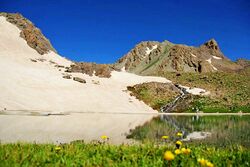
Jilu
Located between the tribes of Baz and Gawar. The Tyari tribes are just to the west. Its speakers tend to have a distinct dialect, with shortened vowels, where /a/ turns into /e/ (e.g. raba or "plenty" is reba). They tend drop the t in some words and/or use 'y" instead (kteta or "chicken" is kteya and khata or "sister" is kha). Ta in Standard Assyrian (meaning "come") is hiya in the Jilu dialect. Those of Baz and Gawar tribes may also have these features in their speech, but it's mostly Jilu people that have retained these conservative sounds in the modern era.
- Alsan and Meedi
Located in Demirli, Yüksekova, Alsan was native to roughly 100 households with an ancient church dedicated to St. Michael. Nearby Meedi, was a mixed settlement of Assyrians and Kurds under the jurisdiction of Greater Jilu. Before 1915 there were about 10 Assyrian households in that village.
- Ishtāzin
Located in Yeşiltaş, Yüksekova, the Ishtāzin valley was a sub-district of Jīlū. This long valley, which runs from northwest to southeast, near a tributary of the Great Zab. By the 1840s it was the only Kurdish-inhabited village in the Ishtāzin valley. In 1850 the Assyrian population of these villages was about 250 households, and by 1915 they would have increased to about 450 families. There were also five churches in the Ishtāzin valley, two of which were dedicated to St. George and St. Mary. The Assyrians of Ishtāzin were led by a Malik (chieftain), who resided in the village of Samsikké. After 1918, the Assyrians of Ishtāzin were dispersed. Many of them went on to form communities in Georgia, Iran, and also in Russia, Iraq and Syria.[28]
- Mata d-Mar Zay'a
The village of Mar Zay'a, in Çevrecik, Yüksekova, was a purely Assyrian settlement occupied by 70 households before 1915. Its ancient church was built by St. Zaya and his disciple St. Tavor in 427 AD. For centuries the village served as the seat of the Mar Sargis metropolitan bishops of Jilu, whose jurisdiction also extended as far as the districts of Baz, Tkhuma and Rekan. The church of Sts. Zay'a and Tavor served as their cathedral. The Assyrians of Mata d-Mar Zay'a were mostly settled in the village of Khirsheniya, in the Dohuk province of north Iraq, in 1922. Most of them, however, went on to create urban neighbourhoods, such as the Jilu Camp (Camp al-Sikak) in Baghdad, Jilo Mahallesi in Kirkuk and Sarbaz in Tehran.
- Sāt
Located in İkiyaka, Yüksekova, Sāt (also known as Sāten) was mixed Assyrian-Kurdish settlement. The Upper and Middle sections of the village were occupied by Kurds, the Lower part was populated solely by Assyrians. At that time, it was home to more than 300 people with an ancient church dedicated to St. Mārī the Apostle and Proselytiser of the East, and a village school run by the local Chaldean Catholic priest. The church was significant as being the only one in the Hakkâri highlands dedicated to that particular saint, and it was believed to have been built in the 3rd or 4th century. Also near the village was a mountain shrine called Mārī'm, sacrosanct to both Christian Assyrians and Muslim Kurds alike.[29]
Kespiyanish
Located in Mutluca, Beytüşşebap, Şırnak Province, the village of Kespiyanish is now a Kurdish settlement and it is not mentioned in any Syriac sources, manuscripts, or travelers' accounts from the 19th and 20th centuries. Its name though is similar to that of other known Assyrian villages, such as Minyanish, Sharanish, Alanish, Maranish, Azyanish, etc. Furthermore, author and scholar Gordon Taylor reported that, when he visited Kespiyanish in 1977, he was shown the intact structure of the village's old Assyrian church. It is not known if this structure still stands today.

Lewin
Located in Geçitli Bucağı, Hakkari, the district of Lewin (Levin) is located in the northwest of Hakkari province and contained roughly 11 Assyrian settlements, with about 7 churches and monasteries before 1915. Up to 3,600 Assyrians (about 600 families) lived there, all of whom belonged to the Church of the East. The religious centre of the district was the village of Mata d-‘Umra d-Mar Giwargis d-Khargil which, in 1607, was the seat of a bishop named Mar Dinkha. In 1935, many Assyrians from Lewin were resettled in the village of Tell-Kayfchi, on the banks of the Khabur River in Syria. There they built a new church dedicated to St. George of Khargil.
Mar b'Ishu
Located in Sarıkaya, Yüksekova, on the Turkish-Iranian border, close to the tribes in Targavar Rural District in Iran, Mar b'Ishu was inhabited by roughly 350 menages. It was home to a 5th century monastery dedicated to St. Beh-Isho' of Kmol, which was destroyed in the war between the Turkish military and the PKK in the 1980s. At the end of the 19th century, the Kurds ravaged the villages in Mar Bisho with so many of the residents fleeing to Iran, where they founded seven villages in Bradost, eight in Margawar and seventeen in Tergawar. A group of Assyrians from Mar-Bhishu settled in the village of Tell-Shamiran, along the Khabur River in Syria, in 1935. Others settled in the village of Qal'ah d-Qasha Avner, near Urmia in Iran. In both villages they built new churches in honor of St. Beh-Isho'.
Marga
Situated in Yemişli, Uludere in the Şırnak Province, Marga was a purely Assyrian settlement prior to 1925. Its name in Syriac means a pasture or meadow. In 1914 it was home to about 800 people (150 families), with an ancient church dedicated to St. Abraham. Around the mid-19th century the Assyrians of Marga converted from the Church of the East to Catholicism and came under the authority of the Chaldean Patriarchate of Babylon. Because of Marga's location right on the Iraqi-Turkish border, the villagers were displaced by the Turkish military in 1925. After their final banishment from Turkey, the Assyrians of Marga were resettled in the villages of Levo, Navkandala and Pirakka, near Zakho in north Iraq. In Levo they built a new church dedicated to St. Abraham. The largest community of "Margaye" outside the Middle East is now in Melbourne, Australia. Margaye people are known to pronounce words that have a T sound with an S, so for instance "beta" ('house') will be "besa". This is a feature also present in the Senaya dialect, an Assyrian variety based in Iranian Kurdistan.
Nochiya
Located on the eastern periphery of Hakkari, on the Turkey-Iran border. The Nochiya dialect is the most similar to Urmian of the Hakkari varieties, where they pronounce words akin to those of Standard Assyrian or Iraqi Koine (beta, kteta, ta, dooli). Unlike the Urmian dialect though, they lack Farsi influence, such as the use of [v] instead of [w], and they would use an [e] sound instead of [i] for ika ("where"), just like the other adjacent Hakkari dialects. Moreover, some varieties may say "msawoteh" ("speaking"), akin to the Tyari dialects, instead of "hamzomeh", which is in Urmian and Standard Assyrian.
- Bé-Dīwé
Bé-Dīwé, in Beyyurdu, Şemdinli, was home to upwards of 25 households with two ancient churches dedicated to St. John the Baptist and St. Cyriacus, as well as a shrine to St. 'Avdā. The name Bé-Dīwé is Assyrian, and derives from the Syriac or Aramaic phrase Beth-Dīvé, meaning, "Home of the Wolves". In 1922 the Assyrians of Bé-Dīwé (Bādūnāyé) were mostly resettled in villages of Iraq's Erbil governorate. Some of them were later resettled in the village of Fell-Faydhah, on the banks of the Khabur River in Syria, in 1935.
- Mār Dinkhā and Tīs
Located in Soğuksu, Şemdinli was home to upwards of 30 homes. Nearby Tīs had the ancient monastery of Mār Dinkhā. The last bishop of this family was killed by invading Ottoman personnel outside the village of Charbash, near Urmia (Iran), in February 1915, during the Assyrian Genocide. The former Catholicos-Patriarch of the Assyrian Church of the East, Mar Dinkha IV, belongs to this family, and Tīs is his ancestral village. In 1922 the Assyrians of Tīs and 'Umra were mostly relocated in the village of Darbandoke in Iraq's Erbil province. Some of them were later resettled in the village of Fell-Faydhah, on the banks of the Khabur River in Syria, in 1935.[30]
- Rustaqa
Situated in Yaylak, Şemdinli, the village of Rustaqa was the spiritual capital of the Nochiya district's Assyrian Christians. Before 1915 it was a purely Assyrian settlement inhabited by 25 households, including that of the Matran family. It was both home to a 5th century monastery dedicated to St. Isho', as well as the seat of the Mar Khnanishu metropolitans of the Church of the East. Rustaqa was the birthplace of St. Mar Yosip Khnanishu. The Assyrians of Rustaqa were mostly settled in the village of Harir, in Erbil province of north Iraq, in 1922.[31]
- Sarunis
Located in Öveç, Şemdinli in Hakkari, Saranus was home to as much as 40 households with an ancient church ordained to the Virgin Mary, Mother of Christ. In 1922 the Assyrians of Sarunis were mostly resettled in the villages of Hinnare and Darbandoke in Iraq's Erbil province. Some of them were later relocated in the village of Fell-Faydhah, on the banks of the Khabur River in Syria, in 1935.
- Shapatan
In modern-day Şemdinli, Hakkari, the district of Nochiya (Navçiya, Dağ İçinde) was flecked with more than 30 Assyrian communities preceding 1915. At that time, over 700 Assyrian families dwelled there, and they had approximately 34 churches and monasteries. The name Shapatan goes back to ancient times, when it was a province of the Assyrian Empire. The Assyrians of Nochiya were mostly settled in villages of Erbil province in northern Iraq, such as Diyana, Hawdiyan, Harir, Batas and Darbandoke, in 1922. A few relocated in the village of Tell-Faydah, along the Khabur River in Syria, in 1935.[32]
- Silvaneh District
In Targavar Rural District, there are 1,019 Assyrians in the purely Assyrian town of Mavana, along with a few thousand more in other villages throughout the district and in the Margavar Rural District to the south.
Benturé
Located in Çubuklu, Şemdinli, Benture was home to more than 20 households with an ancient church. Its name may derive from the Syriac phrase "Beth-Naturé", which means "Place of the Guards", but most likely comes from the Syriac phrase "Bayn-Turé", meaning "Between the Mountains". The Kurdish name for the region around the village derives from the phrase "Nav-Çiya", which also has the same definition. In 1922 the Assyrians of Benturé were mostly relocated in villages of Iraq's Erbil province. Some were later resettled in the village of Fell-Faydhah, on the banks of the Khabur River in Syria, in 1935.[33]
Tkhuma
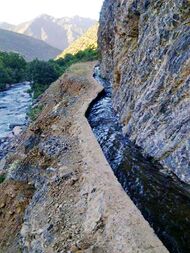
Just to the east of Tyari and southwest of Jilu, they have a dialect similar to Tyari, except they say "sha" for "ta" ('come') whereas Tyari people say "hayo".
- Berijaye
Lying in Kaynaklı, Çukurca, Berijaye contained three churches, the largest of which was dedicated to St. Cyriacus (Mar Quryaqus), located outside the village near a water-powered mill - called Dêra Laşawê by local Kurds today. The others were dedicated to St. George (Mar Gewargis) and St. Jonah. It was one of the last villages to capitulate on 15 September 1915, when the Assyrians were forced out of Hakkari by Ottoman troops and their Kurdish allies. The Assyrians of Berijaye were mostly settled in the hamlet of Tell-Mukhadah, along the Khabur River in Syria, in 1935. There they built a new church dedicated to St. Cyriacus.
- Gawaya
Located in Çeltik, Çukurca, the village was the literal centre of the Tkhuma Assyrian tribal district. Prior to the First World War it was a purely Assyrian settlement, inhabited by 650 Assyrian families. It was also home to an ancient church dedicated to St. Shallita, and was the residence of the chieftains or maliks of Tkhuma. The Assyrians of Tkhuma Gawaya were mostly resettled in the villages of Tell-Hirmiz and Umm-Ghargan, along the Khabur River in Syria, in 1935. In Tell-Hirmiz, they built a new church dedicated to St. Shallita.
- Gundiktha
Situated in what's now Başak, Çukurca, to the west of Baz and Jelu and just east of Tyari, it was home to 350 families. Its ancient church was dedicated to St. Ananias of the Oaths (Beth-Khanya d-Momatha). Local Kurds now know the church as Derâ Miskin. This church was notable for a cross called the "Oath Cross". The belief was that if someone incorrectly swore an oath on this cross they would suddenly die. The Assyrians of Gundiktha speak a dialect similar to Tyari people. They mostly settled in the villages of Tell-Sakrah and Tell-Shamah, along the Khabur River in Syria, in 1935. In each village they built a church dedicated to St. Ananias.[34]
- Gissa
Located in Yapraklı, Çukurca contained 75 families and featured an ancient church dedicated to the 4th century Martyr Saint and Catholicos Mar Shim'on Bar-Sabba'e. It was one of the last villages to surrender on 15 September 1915, when the Assyrians were forced out of Hakkari by Ottoman troops and their Kurdish allies. The Assyrians of Gissa were mostly settled in the village of Tell-Kharitah, along the Khabur River in Syria, in 1935.
- Mazra
In Manastırı, Çukurca, it was home to 300 families before Seyfo. Its Turkish name today is Yaylak. Its spiritual centre was the 4th century Monastery of Rabban Pithyon, which was also a highly regarded place of pilgrimage across the Hakkari highlands, famed for its golden cross. This monastery is located between Mazra'ya and nearby Tkhuma Gawaya, and is known to local Kurds as Derâ Berujî. It was established by the monk Rabban Pithyon, who was a nephew and disciple of St. Eugene. The Assyrians of Mazra'ya were mostly settled in the villages of Tell-Rumman Tahtani and Tell-Wardiyat, along the Khabur River in Syria, in 1935.[35]
Tyari (Lower)
Tyari lies on the western periphery of the Hakkari province, with some villages being just within the Sirnak province. Tyari (and incidentally, Barwari) people have a distinguishable dialect which features, and rather retains, the conservative voiceless th and voiced th sounds instead of dental stops, t and d, which are used in many other Assyrian dialects. A distinctive feature among Tyari speakers is saying hayo for ta ("come") and hola for doola ("there"). Each Tyari village will have subtle dialect differences. Most of the Assyrians from Lower Tyari resettled in Northern Iraq.
- Arosh
An Assyrian tribe in Ortaköy, Uludere, just south of Geramon and Halmon. Located in Sirnak province, it closely borders the Hakkari province and also the Iraq border. The Sirnak portion is known as Ārosh Taxtayta (Lower Arosh) and the Hakkari part is called Ārosh Alayta (Upper Arosh), which is now designated as Yukariarus, a small hamlet. Due to the close proximity of the tribes, some Arosh people have mixed with those in Geramon, which lies a few kilometers north of the tribe, and they may be confused for them.
- Ashithā
Located in Çığlı, Çukurca, Ashita was home to nearly 800 families with a church dedicated to St. George and a shrine to St. Abraham. The village was divided into the following quarters: Isroor, Meweetha, Matha d-'Umra (Khateebin), Chammaneh and Chammaneh Khtaitha. The name Ashitha comes from the Assyrian word meaning "avalanche", because a part of the village is prone to that natural phenomenon. Even the modern Turkish name of the village, Çığlı, comes from the Turkish word Çığ, meaning "avalanche". In 1922, the Assyrians of Ashitha were mostly resettled in villages of Nineveh Governorate and Dohuk provinces in northern Iraq, mainly in Sharafiya, Bakhetme and Sarsing. Furthermore, most Tyari Assyrians tend to be from Ashita (Ashetnaye) and it is one of the most common Assyrian tribe.[36]
- Belāthā
Situated in Taşlık, Çukurca, Belatha was home to 100 families, and was also the village where the chiefs of Lower Tyare resided. Belatha is held to be one of the four original villages of the Tyare districts. Many Assyrians from the districts of Upper Tyare and Tkhuma, as well as the Be-Nikho and Be-Majje clans of Ashitha, have their heritage here. Above the village was the ancient monastery of St. Babai, which still stands today. The name Belatha comes from the Syriac phrase "Beth-'Allatha," meaning "place of fruits" or "place of crops". It may also derive from the Syriac phrase "Beth-'Ilyatha," meaning "place of the heights". The Assyrian dance "Belati" originate from this village. After 1924, Assyrians from Belatha settled in several villages of north of Amadiya and in the Nahla valley in the district of 'Aqrah in Iraq. In the 1960s, the Assyrians of Chamme-Sineh were forced out by Kurds and eventually resettled in the nearby village of Kashkawa. Unlike other Lower Tyari dialects, they would say didan, as instead of diyen for "our" (possessive plural).[37]
- Bne Gipa
An Assyrian settlement just to the south of Minyanish, in Cukurca. At the start of World War I, the people of the Bne Gipa village were dispossessed and impoverished. Had enough of sharing villages with other Assyrians, they had patiently waited for the end of the War with the anticipation that they would be allowed to return to their native homelands in the Hakkiari Mountains. They temporarily settled in Mayeh village in the Barwar region where they were to stay there from 1914 to 1916. They consequentially moved to Male Arab, a village near Zakho, for a year and a half. In 1922, around eighty families built three villages on a remote track of empty land alongside the Khabour River in Northern Iraq. The 3 villages were Gonda Kosa, Gonda Naze and Hara Kunda Sindy.
- Gérāmon
Located in Yarma, Uludere in Sirnak province, in the valleys (Galliyane) west of Tyare, Geramon was home to more than 80 households, containing a 6th-century church that was dedicated to St. John the Arab. From 1922 onward, the Assyrians of Geramon immigrated to Iraq. Its inhabitants are called Geresenayeh. Due to its very close proximity to Halmon, the tribes share a cultural symbiosis and have an affinity towards each other. As such, many Assyrians from Iraq fallaciously consider Halmonaye as being Geresnaye, whereas those from Syria, conversely, label people from Geramon as Halmonaye. Moreover, Aroshnaye are a tribe within their vicinity who may also be confused for either of them.[38]
- Halmon
Located in Andaç, Uludere, Halmon is around 500 meters away from Geramon (Yarma, which is now part of Andaç as well) and, as such, the two groups are affiliated with each other and have intermarried. The village consisted of over 60 households, with a 4th century church dedicated to St. Shmuni. The Assyrians of Halmon were eventually settled in the village of Cham-Suske, in the Dohuk province of northern Iraq, in 1922, after violence and persecution. Afterwards, some were resettled in the village of Tell-Jum'ah, along the Khabur River in Syria, in 1935.
There are many Assyrian songs that have the word Halmon in their titles and lyrics. The songs are usually associated with the Assyrian folk dance. Adwar Mousa is a prominent Assyrian singer and lyricist from Halmon.
Unlike other Assyrian tribes, Halmonites are the only speakers who have retained the classical Syriac diphthong [eɪ̯] in words like psheyna ("greetings") and kheyla ("power"), where in other dialects and also Standard Assyrian speech (or Iraqi Koine), the monophthong /ɛ/ is used instead. Nonetheless, in formal speech, hymns and some forms of nationalistic music, /ɛ/ may be diphthongized in Standard Assyrian as well.[39]
- Lizan
In Köprülü, Çukurca, Lizan was contained 80 households with an ancient church dedicated to St. George. The Assyrians of Lizan were forced out of their village in 1915 and again in 1924. The village was known for its famous bridge, which spanned the Upper Zab River between Lizan and the Kurdish village of Geyman. As such, the contemporary Turkish name for the village means "bridged". Currently, the church of St. George in Lizan is being used as a barracks by the Turkish military, which supervises the nearby Kurdish village of Geyman, as well as the Iraqi border nearby. The Assyrians of Lizan originated from the village of Matha d-Qasra (Qasran, now known as Güllüce). After 1925 the Assyrians of Lizan were resettled in the districts of Barwari-Bala and Nahla in northern Iraq's Dohuk and Ninawa governorates.[40]
- Minyānish
Located in Güzeldere, Çukurca, Minyānish was one of the largest villages in Lower Tyāré inhabited by more than 100 menages. The four ancient churches of the village were dedicated to the Virgin Mary, St. Shmuni, Rabbān Yāqu and Rabbān Sāhdā. The Assyrians of Minyānish are believed to originate from the ancient village of Lagippā, also in Lower Tyāré, and they must have settled there sometime prior to the 10th century, over 1,000 years ago. After 1924, the Assyrians of Minyānish were settled in northern Iraq. Their most important settlement there, right now, is the village of Kashkāwā in the Nahlā Valley north of the town of 'Aqrah (Akre). Unlike the other Lower Tyari tribes, they use "sh" sound instead of "th" or "t" – So "beta" (house) will be "besha".[41]
- Zawita
An Assyrian village near Çukurca. Zawita in Northern Iraq was named after this village, after the Assyrians settled there.
Tyari (Upper)
The valley of Upper Tyare, in Hakkari, straddles the banks of the Upper Zab River. Up until 1915, this valley contained 20 purely Assyrian settlements (not including those in side valleys, such as Koh, Malota d-Malik, Mabbuwa, Rumta, Qallayatha, Sarspidho, etc.). At that time, these 20 settlements contained as much as 450 Assyrian families with 8 ancient churches. The dialects of the Assyrians in the Upper Tyari area, unlike those in Lower Tyari, generally use an "sh" sound instead of "th" for words like "beta" ("besha"), meaning "house"
The Assyrian settlements in the Upper Zab valley of Uper Tyare included: Zorawa, Chamba d-Badal, Dizza, Chamba Khadta (Chamba d-Mira), Darawa d-Walto, Chamba d-Hasso, Roma Smoqa, Be-Mariggo, Chamba d-Kurkhe, Dadosh, Chamba d-Tuwan, Be-Dalyatha, Chamba d-Malik, Be-Samano, Chamba d-Rora, Mazra d-Rumta, Chamba d-Be-Eliya, Chamba d-Qurdaye and Siyadhor.
The descendants of Assyrians from the Upper Tyare valley now live in the village of Kore-Gavana in northern Iraq's Dohuk province, as well as the villages of Tell-Tamr and Tell Tawil on the banks of the Khabur River in Syria.
- Mazra d-Rumta
In Kaynaklı, Hakkari, Mazra d-Rumta was a purely Assyrian settlement home to roughly 5 households. This was one of the more than 10 hamlets in the Rumta sub-district of Upper Tyare, known in Kurdish as Rumtik or Rindke. The village of Mazra d-Rumta was based around the 5th century Monastery of St. Sava, which was a major pilgrimage site and served as an abode for the patriarchs of the Church of the East, whenever they would visit the Upper Tyare valley. Most Assyrians from Rumta were resettled in the village of Tel-Taweel, on the banks of the Khabur River in Syria, in 1935. Unlike the majority of Tyari tribes, they use "sh" sound instead of "th" or "t" – So "beta" (house), which is in standard Assyrian, will be besha. They would also say didan as instead of diyen, for "our", like those of Belatha and unlike other Assyrian dialects.[42]
- Qalaytha
Located in Geçimli, Hakkari, Qalaytha (or Kelayta) was home to roughly 65 households. Their main church was built in 1818 and was dedicated to Christ's Holy Sepulcher in Jerusalem (Qaddishta). Other shrines in the village were dedicated to St. John and St. Abba Macarius. Today the village, which has been repopulated by Kurds, mainly serves as the location of an important Turkish military base. The Assyrians of Qalayatha were largely resettled in Tell-Tamr, on the banks of the Khabur River in Syria, in 1935.
- Chamba d-Malik
Situated in the modern village of Olgunlar in Hakkari, the village was home to more than 60 households and was the residence of the Maliks of Upper Tyare 'Most notifiable the MalikIsmail Family'. The ancient church in was dedicated to St. Sergius the Martyr (Mar Sargis). There was also a monastery near the village dedicated to St. Abraham, where the Chaldean Catholic bishop Mar Abraham d-Bet Mar Shimun died in 1915. In 1935, the Assyrians of Chamba d-Malik ("Chammanaye") were relocated in the village of Tell-Tamr, on the banks of the Khabur River in Syria. There they built a new church dedicated to St. Sergius and St. George, which belongs to the Ancient Church of the East.
- Walto
- Khidhyana and Resha d-Nahra
Located in Ceylanlı, Hakkari, the villages of Khidhyana and Resha d-Nahra ("Head of the River") were purely Assyrian settlements. At that time, Khidhyana was had about 100 Assyrian households with an ancient church dedicated to St. John. Resha d-Nahra was inhabited by roughly 50 households and its church was dedicated to the Virgin Mary. In 1935, most of the Assyrians of Khidhyana and Resha d-Nahra were resettled in the village of Tell Nasri, on the banks of the Khabur River in Syria. There, with other Assyrians from the Walto valley, they built a new church dedicated to the Virgin Mary.
- Sirta
Located in Sütçüler, Hakkari, the village of Sirta was home to at least 80 households. It was situated in the district of Walto, and its church was dedicated to St. John. The Assyrians of Sirta were mostly resettled in the village of Tell-Nasri, along the Khabur River in Syria, in 1935. There, they inhabit their own neighbourhood in a village populated only by other Assyrians from the Walto district.
- Ishta d-Nahra
Located in Derav, Hakkari, its Assyrian name means "the end of the river", since it was located at the concourse of the Walto River with the Upper Zab. Its more ancient name, found in Syriac manuscripts, is "Tra'-Nahra" (meaning the River's Gate). Prior to 1915, Ishta d-Nahra was home to more than 30 Assyrian households, with an ancient church dedicated to St. Eugene the Blessed (Mar Awgin, or Mar Marogen), who lived in the 4th century. The Assyrians of Ishta d-Nahra were mostly resettled in Tell-Tamer on the banks of the Khabur River in Syria, in 1935. They did not build a new church dedicated to St. Eugene, but still kept the cross from this church and celebrate his feast day every year.
Western Assyrian tribes
- Batman Province
- Benkelbé
- Hesno d'Kifo
- Zercel (was predominantly populated by Assyrians until 1967)[43]
- Yerdo (uninhabited by Assyrians as of August 1996)[44]
- Dayro Kuryakos[45]
- Keferzo Fevkani[46]
- Keferzo Taxtani[47]
- Diyarbakır (Amidnaye Tribe) – To note, although it is situated on the western periphery of the Assyrian homeland and is proximate to the Central Neo-Aramaic speakers, the people of this tribe actually speak Assyrian Neo-Aramaic (a Northeastern Neo-Aramaic language) rather than Turoyo (a Central Neo-Aramaic language), containing both Tyari and Urmian features.
- Anhel
- Arbo
- Beth Qustan
- Çatalçam
- Deyrkubé
- Mzizah
- Gülgöze (inhabited)
- Güngören[48]
- Karboran
- Kfarze
- Ömerli (inhabited)[49]
- Mardin (inhabited)
- Midyat (inhabited)
- Mzizah
- Nisibis
- İzbırak (inhabited)
- Tur Abdin (Amnokiye Tribe,[50] Beth Haydo, Bet Shimun)
- Zaz
- Şırnak Province
- Meer, Beytüşşebap
See also
References
- ↑ Poizat, Bruno, "The Sureth-Speaking Villages in Eastern Turkey," Journal of the Assyrian Academic Society, 1985–86, Vol. I, no. 1
- ↑ M.Y.A . Lilian, Assyrians Of The Van District During The Rule Of Ottoman Turks, 1914
- ↑ Smith, Gary N., From Urmia to the Stanislau: a cultural-Historical-Geography of Assyrian Christians in the Middle East and America (Davis, 1981)
- ↑ Atiyah, Aziz S. A History of Eastern Christianity (South Bend, Ind., 1968)
- ↑ Joseph, John, The Nestorians and their Muslim Neighbors (Princeton, 1961)
- ↑ Wigram, W.A., "The Ashiret Highlands of Hakkari (Mesopotamia)," Royal Central Asian Society Journal, 1916, Vol. III, pg. 40. -- The Assyrians and their Neighbors (London, 1929)
- ↑ Costa-Roberts, Daniel (15 March 2015). "8 things you didn't know about Assyrian Christians". PBS. https://www.pbs.org/newshour/rundown/8-things-didnt-know-assyrian-christians/. Retrieved 6 July 2015.
- ↑ Assyrian villages in Hakkari Assyrian villages in Hakkari
- ↑ Dalley, Stephanie (1993). "Nineveh After 612 BC." Alt-Orientanlische Forshchungen 20. P.134.
- ↑ http://www.jaas.org/edocs/v20n1/Arianne-diaspora.pdf
- ↑ Rev. Justin Perkins : “A residence of eight years in Persia among the Nestorian Christians”, New York, 1843 – P: 304.
- ↑ Dyson, Robert H (1965). "Problems of Protohistoric Iran as Seen from Hasanlu"; Journal of Near Eastern Studies, Vol. 24, No. 3, pp. 193-9.
- ↑ Dyson, Robert H. (1989) "The 'Ḥasanlu Gold Bowl': Thirty Years Later," in Robert H. Dyson Jr. and Mary Mathilda Voigt, eds., East of Assyria: The Highland Settlement of Hasanlu, Expedition 31/2-3, pp. 87-106.
- ↑ Smith, Natalie Jill. "Ethnicity, Reciprocity, Reputation and Punishment: An Ethnoexperimental Study of Cooperation among the Chaldeans and Hmong of Detroit (Michigan)" (PhD dissertation). University of California, Los Angeles, 2001. p. 61. UMI Number: 3024065.
- ↑ Indigenous People in Distress, Fred Aprim
- ↑ Islamic Desk Reference, E. J. van Donzel
- ↑ A Modern History of the Kurds, David McDowall
- ↑ Stafford, Ronald Sempill (2006) [1935], The Tragedy of the Assyrians, Gorgias Press, p. 41, ISBN 978-1-59333-413-0, https://books.google.com/books?id=LSzuzsRh37gC&pg=PA32
- ↑ Gaunt, David; Beṯ-Şawoce, Jan (2006), Massacres, Resistance, Protectors: Muslim-Christian Relations in Eastern Anatolia during World War I, Gorgias Press, p. 32, ISBN 978-1-59333-301-0, https://books.google.com/books?id=4mug9LrpLKcC&pg=PA32
- ↑ "The wild Christian tribes of Hakkari, whither no Government of any sort has ever extended, still pay tribute to their Patriarch for transmission to the Sultan; and not taxes through the tax-collector"
- ↑ Stafford, Ronald Sempill (2006) [1935], The Tragedy of the Assyrians, Gorgias Press, ISBN 978-1-59333-413-0, https://books.google.com/books?id=LSzuzsRh37gC
- ↑ Alexander 1994, p. 36[full citation needed]
- ↑ Wilmshurst, David, The ecclesiastical organisation of the Church of the East, 1318-1913, Leuven: Peeters Publishers, 2000, p. 300
- ↑ http://www.aina.org/maps/eastern/map_assyria_amadiya.jpg
- ↑ Coakley, J.F., The Church of the East and the Church of England: A History of The Archbishop of Canterbury's Assyrian Mission, Oxford: Clarendon Press, 1992, pp. 175 and 178
- ↑ Dauphin, C., "Rediscovery of the Nestorian Churches of the Hakkari (South Eastern Turkey)," Eastern Churches Review, Vol. VIII, 1976, pp. 56-57
- ↑ Zinda Magazine XI (58). 2 November 2005. http://www.zindamagazine.com/html/archives/2005/11.2.05/index_wed.php. Retrieved 2019-11-24.
- ↑ Lālāyān, K.A., Āthorāyé d-Māhal d-Wān, Tehran: Assyrian Youth Cultural Society Press, 1968, pp. 27-31
- ↑ Chabot, J.B., Synodicon Orientale, Paris, 1902, p. 285
- ↑ Stafford, Ronald Sempill (2006) [1935], The Tragedy of the Assyrians, Gorgias Press, p. 41, ISBN 978-1-59333-413-0, https://books.google.com/books?id=LSzuzsRh37gC&pg=PA32
- ↑ Stafford, Ronald S., "The Assyrians in the Mosul Vilayet," Royal Central Asian Society Journal, 1934, Vol. XXI, p. 237.
- ↑ A modern history of the Kurds, David McDowall
- ↑ Solomon (Sawa) Solomon from Nineveh Magazine 1st & 2nd quarter 1997, vol. 20, no 1&2.
- ↑ Dodge, Bayard, "The Settlement of the Assyrians on the Khabur," Royal Central Asian Society Journal, July 1940, pp. 301-320.
- ↑ Rowlands, J., "The Khabur Valley," Royal Central Asian Society Journal, 1947, pp. 144-149.
- ↑ Sykes, BG Sir Percy, "The Assyrians in Iraq: A summary of their history from 1918-1933," Royal Central Asian Society Journal, 1934, Vol. XXI, p. 269.
- ↑ "Mor Malki Ürek". http://soc-wus.org/ourchurch/Pat_V_Adiyaman.htm.
- ↑ Rassam, A. Hormuzd, "Non-Arab Minorities of Iraq," Royal Central Asian Society Journal, 1931, Vol. XVIII, p. 564.
- ↑ Chevalier, Michel, Les Montagnards Chrétiens du Hakkari et du Kurdistan Septentrional (Paris, 1985)
- ↑ Brigadier-Gen. H.H. Austin, "The Baqubah Refugee Camp", The Faith Press, London. 1920.
- ↑ Bird, Isabella. "Journeys in Persia and Kurdistan, including a summer in the Upper Karun region and a visit to the Nestorian rayahs". John Murray, London. 1891.
- ↑ Browne, W.H. The Catholicos of the East and His People, Being the Impressions of Five Years' Work in the Archbishop of Canterbury's Assyrian Mission (London, 1892)
- ↑ Index Anatolicus: Danalı
- ↑ Hürriyet Daily News: What happened to the Turkish Assyrians?
- ↑ Index Anatolicus: Ayrancı
- ↑ Index Anatolicus: Yarımtaş
- ↑ Index Anatolicus: Yenipınar
- ↑ Index Anatolicus: Arıca
- ↑ Mardin Travel. "Ömerli". Mardin Travel. http://www.mardintravel.com/omerli/.
- ↑ "Beth Nahle – Anhel – Anhil Anhül – Enhel – Enhil – Yemişli". http://www.xmind.net/m/7QbE/.
Sources
- Chabot, Jean-Baptiste (1902). Synodicon orientale ou recueil de synodes nestoriens. Paris: Imprimerie Nationale. https://archive.org/download/ChabotSynodiconOrientale/chabot%20synodicon%20orientale.pdf.
External links
- Villages in Hakkari prior to 1915 in Turkey (map) (map)
- Villages in Tyari, Amadiya and Barwar, in lower Hakkari (map).
- Villages in the Gazarta region in northern Iraq, bordering south of Hakkari (map)
- Assyrians Of The Van District



